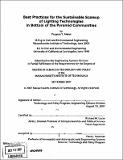Best practices for the sustainable scaleup of lighting technologies in bottom of the pyramid communities
Author(s)
Alekal, Pragnya Y. (Pragnya Yogesh), 1977-
DownloadFull printable version (11.97Mb)
Other Contributors
Massachusetts Institute of Technology. Technology and Policy Program.
Advisor
Richard M. Locke.
Terms of use
Metadata
Show full item recordAbstract
This thesis deduces a set of best practices for sustainably scaling up lighting technologies in developing countries with a focus on Bottom-of-the-Pyramid (BOP) communities, whose annual incomes are US $3000 or less (in local purchasing power parity). The best practices are derived from a comparative analysis of two heuristic case studies profiling entrepreneurs based in southern India, who have successfully scaled up lighting technologies in BOP communities. Also discussed is the impact that quality lighting has on our health, safety, socio-economic status and the environment that surrounds us. Not surprisingly the demand for quality artificial lighting is high in these communities, where access is generally limited. SELCO-India, a registered company, sells photovoltaic-based home lighting systems; while THRIVE, a nonprofit organization, sells Light Emitting Diode (LED) lanterns to remote communities in India. Both organizations use alternative models to address the same issue. While the research presented here focuses on the lighting sector in India, it is also proven that the results are applicable in the context of entrepreneurship in BOP communities around the world.
Description
Thesis (S.M.)--Massachusetts Institute of Technology, Engineering Systems Division, Technology and Policy Program, 2007. Includes bibliographical references.
Date issued
2007Department
Massachusetts Institute of Technology. Engineering Systems Division; Technology and Policy ProgramPublisher
Massachusetts Institute of Technology
Keywords
Technology and Policy Program.